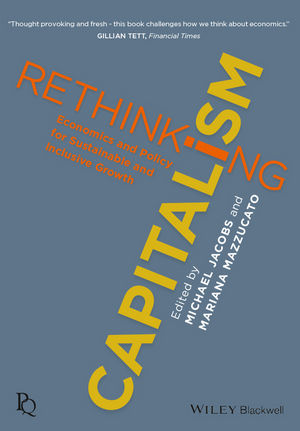
The fall in the rate of growth of labour productivity is a sign of that advanced economies could face a long period of low economic expansion and financial instability, UCL professor Michael Jacobs told the Rethinking Capitalism meeting last night at the LSE.
“In the decade prior to the (global financial) crisis, labour productivity growth was below trend in almost all G7 countries…,” Jacobs and Sussex University professor Mariana Mazzucato say in an article in a new book they have edited. “Since the financial crisis, it has fallen further in most developed countries… At the same time, there appears to be some evidence that rates of productivity-enhancing innovation have also slowed down. All this has led some economists to ask whether Western capitalism has entered a period of ‘secular stagnation’, in which a structural weakness of investment and demand leaves positive interest rates no longer able to support full employment.”
Mazzucato also spoke at the Rethinking Capitalism meeting.
The productivity challenge is regularly cited as a key issue facing economic policymakers, but it may be a false one.
We have a problem with productivity as a credible indicator of economic trends. And it’s getting bigger due to the inexorable rise of services, which account for more than 80 per cent of output and employment in advanced economies.
The abiding issue is the accuracy and relevance of GDP data. As statisticians recognise, aggregating output for an entire economy is sometimes more of an art than a science. And conventional definitions of GDP are unsatisfactory.
Defenders of productivity as an indicator argue that trends in imperfect data can be useful. They have a point, but for economies that mainly produce tangibles.
Tangible production can be physically quantified. But services are intangible and intrinsically impossible to define and measure.
How much does a teacher produce? Or an accountant?
It’s a matter of opinion.
Economists of course refer to price. The productivity of workers in a service business can be calculated by dividing sales revenue by the number of workers.
So a pizza restaurant selling 1,000 pizzas week at an average price of $10 has sales revenue of $10,000. If it employs five people, then its labour productivity is $2,000 a worker.
But, as Economics2030 argues, the amount paid for a service fails to reflect all the value restaurant workers create. Their courtesy and good humour is not embedded in the pizza. It might encourage customers to return to a particular restaurant and boost sales revenue over time. But it might not (and of course the tips that flow between a restaurant worker and happy customers are not recorded in sales).
A further issue is that some service workers may choose to underprice their services.
One reason why this happens is is that people seek value-creating relationships. A pizza restaurant manager, therefore, might decide to set prices below the level happy customers are prepared to pay for his or her efforts merit because he or she prefers them to feel they are getting excellent value for money.
This creates goodwill and a feeling of obligation that is essential for a long-term value-creating relationship. The value this relationship creates is not always fully monetised and often isn’t.
A further factor is that employees of service firms may discourage higher prices because they feel they won’t benefit.
All that higher prices mean for most service employees is a higher degree of exploitation.
There is no way of quantifying the extent to which the intuitive behavior of service workers and managers leads to their output being underpriced.
But it would be a mistake for economists to dismiss this and other factors influencing value-creation and pricing in service industries.
They could be enough to explain why the growth in labour productivity in advanced economies is apparently slowing when most workers feel they’ve never been more productive.
Rethinking Capitalism, edited by Michael Jacobs and Mariana Mazzucato. Published by The Political Quarterly Publishing Company, 2016.